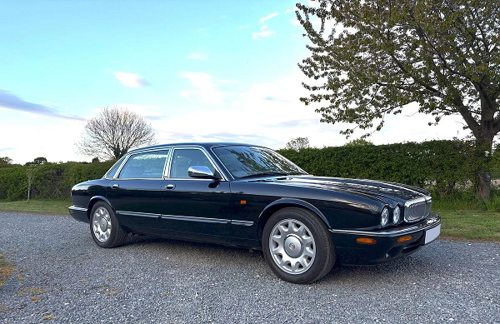“The XJ That Went To Finishing School” - Ken Sadler’s Daimler Super V8 LWB
05 June 2025
It has been 16 years since the Daimler name vanished from the UK’s new car market with the demise of the Super Eight, and cars such as Ken’s 1998 Super V8 are a reminder of what we have lost - https://www.carandclassic.com/l/C1868395

The narrative really starts in 1986 when Jaguar launched the XJ40. The much-modified X300, the first car with the leaping cat badge created under Ford auspices, replaced it in late 1994. Three years later, the facelifted X308 became Jaguar’s first V8-powered car with the demise of the AJ16 inline-six and V12 engines. Ultra-keen drivers could specify the XJR with a supercharged 4.0-litre engine, and Autocar reported:
It’s the most powerful Jaguar XJ engine ever - 15 per cent more so than the six-cylinder supercharged engine in the XJR, which it replaces. The same engine is fitted to the top Daimler model, the Super V8, which has a longer wheelbase than the Jaguar.
The XJR clearly impressed Mr. J. Clarkson as he wrote: “Better still, instead of a driver’s door, the XJR is fitted with a time portal. Step through it and you are taken back to about 1956. I cannot tell you how old-fashioned it feels from behind the wheel. There’s a big cat on the steering wheel boss but you think: ‘No, this can’t be. I’m in a Wolseley’”. The same applied to the Super V8’s cabin, for Daimlers are above the mere vagaries of fashion.
Furthermore, the Super V8’s engine was very much in the Daimler tradition. Since 1972, the top-of-the-range XJ-based Double Six was V12-powered. However, the
latest Daimler reminded some of the remarkable 1959-1968 4.5-litre V8 Majestic Major. The brochure referred to the new model’s ancestry, stating, “The Daimler engineers who produced the Majestic would be awed by the power, refinement and handling of today’s Super V8”.
And the Super V8 was ideal for those motorists who valued discretion, as it lacked the XJR suspension and body kit. After all, one would hate to draw attention to oneself - and to the Super V8’s 375bhp power output. The engine was paired with the Mercedes-Benz 5G-Tronic W5A580 transmission, which Browns Lane believed could handle the additional torque. The Daimler was capable of 0-60 mph in 5.4 seconds and had a top speed electronically limited to 155 mph.
When Autocar tested the Super 8 against its four main rivals in 1999, the Daimler cost £64,795, while the BMW 750Li was £80,115. The Lexus LS400 was £52,423, the Mercedes-Benz S500 was approximately £85,000, and the Rolls-Royce Silver Seraph was a modest £157,793. They described the Super 8 as being “as quick as it is regal. A flawed diamond.”
Additionally, Autocar suggested “If you want your business associates to think you’re a pace-setting go-getter, then avoid the Daimler”. But no true devotee of the marque would ever employ phrases as vulgar as “a pace-setting go-getter”. Nor would they care how business associates viewed them – they were a Daimler owner.
Andrew English of The Telegraph wonderfully referred to the Super V8 as “What a machine. I don’t think there is another such potent iron fist in a velvet glove on sale”. Production ended in 2022, and one of the final examples was the blue Super V8, delivered to Her Majesty the Queen for her private use. This Daimler now belongs to the Jaguar Daimler Heritage Trust - https://www.jaguarheritage.com/vehicle-collection
When Jaguar acquired Daimler in 1960, many feared the imminent demise of one of the UK’s most distinguished marques. However, subsequent models, such as the Double Six Vanden Plas S1, the Double Six Coupe, and the Super V8, were very much in the Daimler spirit. The brochure called the Super V8 “Beyond comparison”.
Or, as Ken puts it: “The XJ that went to finishing school”.
With thanks to Ken Sadler for his time.
With thanks to Ken Sadler for the permission to use the images in this blog.
